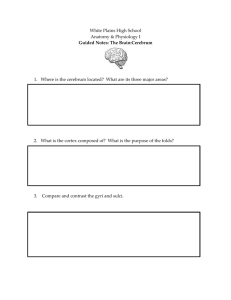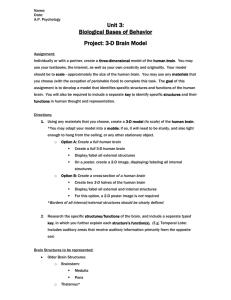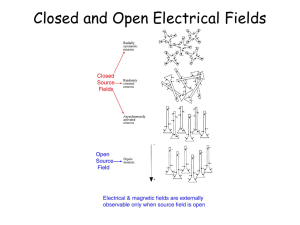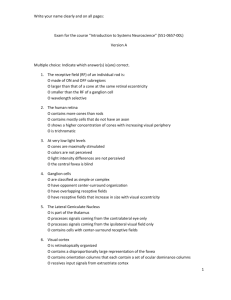Neuroscience 14b – Organisation of the Cerebral Cortex
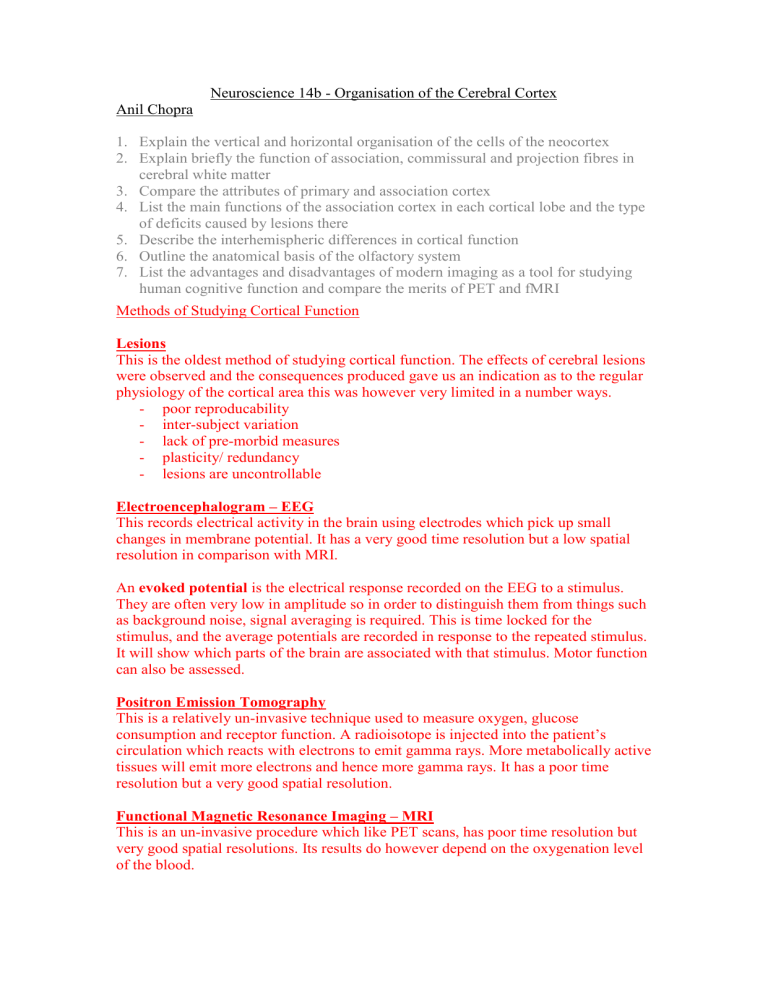
Neuroscience 14b - Organisation of the Cerebral Cortex
Anil Chopra
1.
Explain the vertical and horizontal organisation of the cells of the neocortex
2.
Explain briefly the function of association, commissural and projection fibres in cerebral white matter
3.
Compare the attributes of primary and association cortex
4.
List the main functions of the association cortex in each cortical lobe and the type of deficits caused by lesions there
5.
Describe the interhemispheric differences in cortical function
6.
Outline the anatomical basis of the olfactory system
7.
List the advantages and disadvantages of modern imaging as a tool for studying human cognitive function and compare the merits of PET and fMRI
Methods of Studying Cortical Function
Lesions
This is the oldest method of studying cortical function. The effects of cerebral lesions were observed and the consequences produced gave us an indication as to the regular physiology of the cortical area this was however very limited in a number ways.
poor reproducability
inter-subject variation
lack of pre-morbid measures
plasticity/ redundancy
lesions are uncontrollable
Electroencephalogram – EEG
This records electrical activity in the brain using electrodes which pick up small changes in membrane potential. It has a very good time resolution but a low spatial resolution in comparison with MRI.
An evoked potential is the electrical response recorded on the EEG to a stimulus.
They are often very low in amplitude so in order to distinguish them from things such as background noise, signal averaging is required. This is time locked for the stimulus, and the average potentials are recorded in response to the repeated stimulus.
It will show which parts of the brain are associated with that stimulus. Motor function can also be assessed.
Positron Emission Tomography
This is a relatively un-invasive technique used to measure oxygen, glucose consumption and receptor function. A radioisotope is injected into the patient’s circulation which reacts with electrons to emit gamma rays. More metabolically active tissues will emit more electrons and hence more gamma rays. It has a poor time resolution but a very good spatial resolution.
Functional Magnetic Resonance Imaging – MRI
This is an un-invasive procedure which like PET scans, has poor time resolution but very good spatial resolutions. Its results do however depend on the oxygenation level of the blood.
Grey Matter
The human cerebral cortex is around 2.4 mm thick and its surrounds the cerebral hemispheres. It is split up into 6 distinct layers:
1.
Molecular layer I , which contains few scattered neurons and consists mainly of extensions of apical dendrites and horizontally-oriented axons.
2.
Outer granular layer II , which contains small pyramidal neurons and numerous stellate neurons making intracortical connections to tother parts of the cortex.
3.
Outer pyramidal layer III , which contains medium-size pyramidal neurons, as well as non-pyramidal neurons with vertically-oriented intracortical axons. It receives efferents from layer III and sends afferents to layers I and III.
4.
Inner granular layer IV , which contains different types of stellate and pyramidal neurons, and receives inputs from the thalamus.
5.
Inner pyramidal layer V , which contains large pyramidal neurons it is the principal source of subcortical efferents i.e. it projects to the brainstem, spinal cord and corpus striatum.
6.
Fusiform layer VI , which contains few large pyramidal neurons and many small spindle-like pyramidal and fusiform neurones; it sends efferent fibers to the thalamus, establishing a very precise reciprocal interconnection between the cortex and the thalamus.
All the layers receive inputs from the reticular activation system and brainstem monoaminergic nuclei.
Brodmann’s Areas
: Korbinian
Brodmann split up the cerebral cortex into a number of areas each defined by their function.
White Matter
There is a large amount of white matter contained within the cerebral hemispheres. They consists of different types of fibres:
Association Fibres: these connect one area of the cortex with another within the same hemisphere.
Commissural fibres : interconnect cortical areas of two corresponding hemispheres via the corpus callosum . These ensure that the memory traces in one hemisphere are available to the other hemisphere.
Projection Fibres : these project from the cortex to the subcortical regions, and vice versa (incoming projections mainly come from the thalamus).
o Thalamocortical, corticothalamic, corticopontine fibres pass through both limbs o Corticospinal, corticobulbar fibres pass through posterior limb
Types of Cortex
The neocortex is the largest and most complex part of the cortex. The archicortex and paleocortex are phylogenetically older and part of the limbic system. There are 2 main types of cortical area:
Primary Cortical Area o Smaller o Predictable function o Topographically organised o Unilateral representation o Symmetrical o Stimulation leads to simple moves or sensory experiences.
Association Cortex o Although they are structurally organised, there is no topographic arrangement. o Bilateral representation o Asymmetric o Normally adjacent to the primary area o Their stimulation does not lead to simple reproducible effects. o Can be divided into polymodal and supramodal.
There has also been a third proposed type of cortical area – the higher order areas which carry out further processing of information from primary modalities. They supplement the primary motor areas and integrate information coming from the different systems. e.g. V2-V2 in the visual cortex.
They can be divided up into polymodal and supramodal:
Polymodal (multimodal) association cortex – analyses information from more than one modality eg posterior parietal cortex
Supramoda l cortex – underpins complex behaviour which does not have obvious sensory or motor function. eg. language areas, prefrontal cortex
‘Association cortex’ usually refers to secondary and tertiary.
Functions of the Association Cortex
Frontal Lobes
Association area plans sequences of responses or changes in response to fit the demands and controls of the emotional state
The higher order area is in charge of motor planning especially of eye movements and speech (Broca’s area)
Associated with judgement, foresight, personality, appreciation of self in relation to the world
Damage can lead to o Inability to organise and solve problems o Personality and emotional changes. Patients become more impulsive, aggressive – Disinhibition .
o Disorders of eye movement.
o Disorders with speech production.
o Disorders in working memory.
Temporal Lobes
Association areas involved with learning.
Higher order area involved with comprehension of language (Wernicke’s Area) in left and object recognition in the right.
Damage can lead to o Disorders learning verbal information in left o Disorders learning visiospatial information in right. o Agnosia receptive anaphasia. (cannot recognise visual objects with sight.
Parietal Lobes
Primary sensory area with somatosensory system.
Higher order sensory areas.
Association areas where many sensory modalities and motor inputs converge to build a picture of where the body is in the environment.
Posterior parietal association cortex creates a spatial map of the body and surroundings from multi-modality information.
Damage can lead o Lack of sensation of one half of the body.
o Inability to make voluntary eye movements.
o Attentional deficits.
o Inability to organise movement is space – apraxia. o Defects in route finding and spatial awareness.
o Disorders of language. o Agnosia.
Occipital Lobes
Visual association cortex analyses different features of visual images.
Colour and form are analysed in the ventral pathways.
Spatial relationships and movement are analysed along the dorsal pathway.
Damage can lead to disorders of visual perception.
Interhemispheric differences
Left hemisphere is more concerned with language and sequential analysis.
Right hemisphere more concerned with shape, spatial relationships, music.



